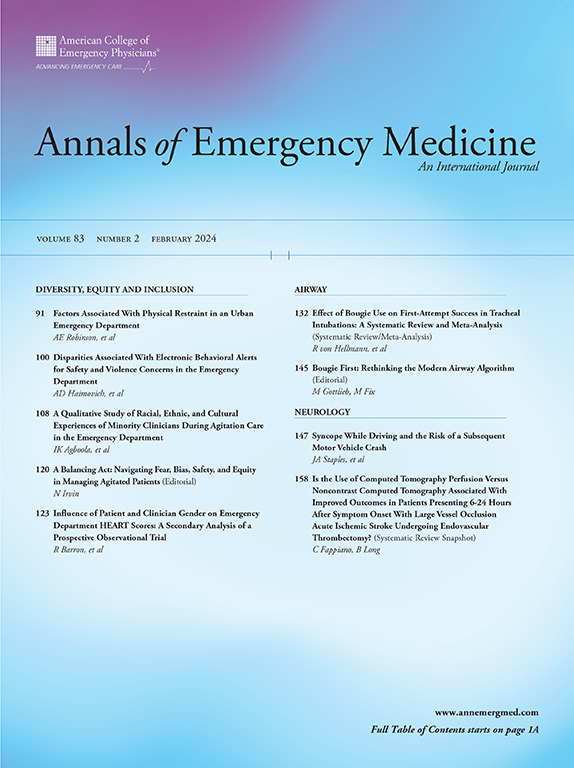Feasibility of Pediatric Diagnostic Quality Measurement in All United States Hospitals.
IF 5
1区 医学
Q1 EMERGENCY MEDICINE
引用次数: 0
Abstract
STUDY OBJECTIVE To evaluate the proportion of emergency departments (EDs) with sufficient volumes to measure pediatric misdiagnosis reliably. METHODS We conducted a cross-sectional study of a nationally representative 20% sample of US EDs within the 2022 Nationwide Emergency Department Sample. We counted the number of child visits (less than 18 years old) at each ED for each of 24 serious pediatric emergency conditions and each ED's total across all conditions. We calculated the proportion of EDs that could reliably measure misdiagnosis rates at least 10% worse than condition-specific national reference standards. We also calculated the proportion of children visiting measurable EDs. RESULTS Reliable misdiagnosis measurement across all serious conditions was possible in 614 out of 4,515 EDs (13.6%, 95% confidence interval [CI] 11.5 to 15.9). Appendicitis was the most reliably measurable condition (n=530 EDs, 11.7%, 95% CI 9.8 to 14.0), whereas complicated pneumonia (n=33, 0.7%, 95% CI 0.3 to 1.5), testicular torsion (n=29, 0.6%, 95% CI 0.2-1.4), and intussusception (n=25, 0.6%, 95% CI 0.2 to 1.2) were less frequently measurable. The 20 other included conditions were not reliably measurable in any ED (0.0%, 95% CI 0.0 to 0.4). Midwest, nonmetropolitan, and EDs evaluating less than 1,800 children per year were least likely to be able to support reliable measurement. Among 185,490 children with a serious condition, 130,894 (70.6%) visited an ED in which misdiagnosis was measurable. CONCLUSION Few EDs have sufficient pediatric volumes to reliably measure diagnostic accuracy generally, and even fewer can do so for individual conditions. Aggregation of EDs could improve power to measure misdiagnosis.美国所有医院儿科诊断质量测量的可行性
研究目的评估有足够容量可靠测量儿科误诊的急诊科(EDs)比例。方法:我们对2022年全国急诊科样本中具有全国代表性的20%的美国ed样本进行了横断面研究。我们统计了24种严重儿科急诊情况下每个急诊科(18岁以下)的儿童就诊次数,以及所有情况下每个急诊科的总数。我们计算了能够可靠地测量误诊率的ed的比例,误诊率至少比特定条件的国家参考标准差10%。我们还计算了儿童访问可测量ed的比例。结果:在4515例急症患者中,有614例(13.6%,95%可信区间[CI] 11.5 ~ 15.9)存在对所有严重疾病的可靠误诊测量。阑尾炎是最可靠的可测量疾病(n=530, 11.7%, 95% CI 9.8至14.0),而并发症肺炎(n=33, 0.7%, 95% CI 0.3至1.5)、睾丸扭转(n=29, 0.6%, 95% CI 0.2至1.4)和肠套叠(n=25, 0.6%, 95% CI 0.2至1.2)较少可测量。其他20个纳入的条件在任何ED中都不能可靠地测量(0.0%,95% CI 0.0至0.4)。中西部地区、非大都市地区和ed每年评估的儿童少于1800名,最不可能支持可靠的测量。在185490名病情严重的儿童中,130894名(70.6%)就诊了可测量的误诊急诊科。结论很少有急诊科有足够的儿科容量来可靠地衡量诊断的准确性,而对于个别情况,能够做到这一点的就更少了。EDs的聚集可以提高诊断误诊的能力。
本文章由计算机程序翻译,如有差异,请以英文原文为准。
求助全文
约1分钟内获得全文
求助全文
来源期刊

Annals of emergency medicine
医学-急救医学
CiteScore
8.30
自引率
4.80%
发文量
819
审稿时长
20 days
期刊介绍:
Annals of Emergency Medicine, the official journal of the American College of Emergency Physicians, is an international, peer-reviewed journal dedicated to improving the quality of care by publishing the highest quality science for emergency medicine and related medical specialties. Annals publishes original research, clinical reports, opinion, and educational information related to the practice, teaching, and research of emergency medicine. In addition to general emergency medicine topics, Annals regularly publishes articles on out-of-hospital emergency medical services, pediatric emergency medicine, injury and disease prevention, health policy and ethics, disaster management, toxicology, and related topics.
 求助内容:
求助内容: 应助结果提醒方式:
应助结果提醒方式:


